JSS University Mysore 2025
NAAC A+ Accredited| Ranked #24 in University Category by NIRF | Applications open for multiple UG & PG Programs
The topic “Prophase I” is from the chapter Cell Cycle and Cell Division Class 11th. According to an analysis of the NEET papers from the previous five years, 18 questions—or about 8% of all the questions asked in Botany—came from the chapter Cell Cycle and Cell Division Class 11th. Out of these 18 questions, six were based on the concept– prophase I Of Meiosis I. You can check out those questions from Prophase I at the end of this article. Let's start with an overview of meiosis, let's examine the stages of Prophase I in more detail.
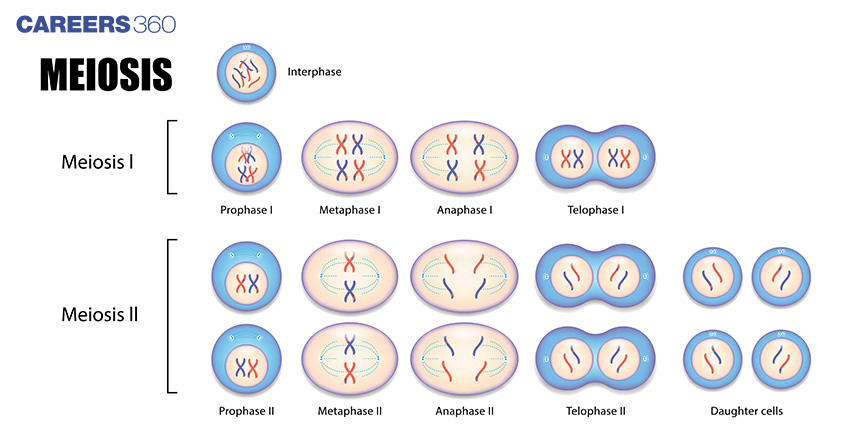
Eukaryotic cells (plants, animals, and fungi) reproduce sexually through a process called meiosis. It is a process of chromosomal reduction, which means that a diploid cell-a cell with two complete and identical chromosome sets-is reduced to form haploid cells - cells with only one chromosome set. Meiosis, also known as reductional division, is the process by which gametes (egg cells or sperm) are produced in sexually reproducing organisms. The division occurs twice, i.e., meiosis I and meiosis II, resulting in four daughter cells having only one copy of each chromosome (haploid).
In the life cycle of sexually reproducing organisms, meiosis ensures the production of the haploid phase, whereas fertilisation restores the diploid phase. Meiosis is a process that both plants and animals go through during gametogenesis. The result is the production of haploid gametes.
Meiosis has the following salient characteristics:
Meiosis involves just one cycle of DNA replication but two successive cycles of nuclear and cell division called meiosis I and meiosis II.
After the parental chromosomes have duplicated to form identical sister chromatids at the S phase, meiosis I begins.
Chromosome pairing and recombination between non-sister chromatids of homologous chromosomes occur during meiosis.
After meiosis II, four haploid cells are produced.
NAAC A+ Accredited| Ranked #24 in University Category by NIRF | Applications open for multiple UG & PG Programs
With the exception of interphase, the stages of meiosis can be divided into 8 stages. These stages are divided between meiosis I (first cell division) and meiosis II (second-time division).
Meiosis I | Meiosis II |
Prophase I | Prophase II |
Metaphase I | Metaphase II |
Anaphase I | Anaphase II |
Telophase I | Telophase II |
Also Read| NEET Cell Cycle Interphase
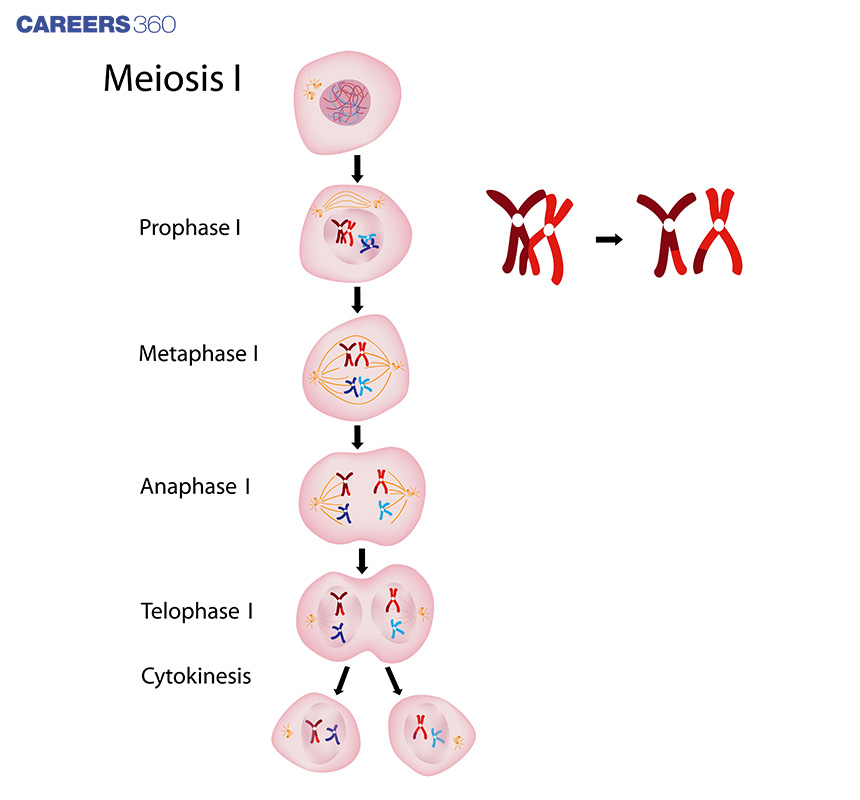
In the cell, the DNA is copied, resulting in the formation of two identical sets of chromosomes and the extension of microtubules from the centrosomes.
1. Prophase I:
An X-shaped structure is formed when the copied chromosomes condense. Each chromosome consists of two sister chromatids that contain identical genetic information. As the chromosomes begin to pair up, both copies of chromosome 1 come together, followed by both copies of chromosome 2, and so on. In a process known as crossing over or recombination, the pair of chromosomes may swap a small amount of DNA. Prophase I comes to an end when the membrane surrounding the nucleus dissolves, releasing the chromosomes. The meiotic spindle, composed of microtubules and other proteins, is extended between the centrioles across the cell.
2. Metaphase I
Along the equator of the cell, the chromosome pairs align. Now centrioles are at the opposite poles of the cell from which meiotic spindles are extended. One chromosome from each pair is attached by the meiotic spindle's fibres.
3. Anaphase I
A pair of chromosomes is then pulled apart by the meiotic spindle so that one chromosome travels to one pole and the other chromosome travels to the opposite pole.
Through a process known as cohesion, the sister chromatids in meiosis I stay together. This is how meiosis and mitosis differ from one another.
4. Telophase I and cytokinesis
The chromosome has successfully moved to the other pole. At each pole, the entire set of chromosomes is gathered. Each set of chromosomes is surrounded by a fresh membrane, producing two nuclei. Then cytokinesis takes place, in which pinches form in the middle to form 2 distinct daughter cells, each of which has a complete set of chromosomes.
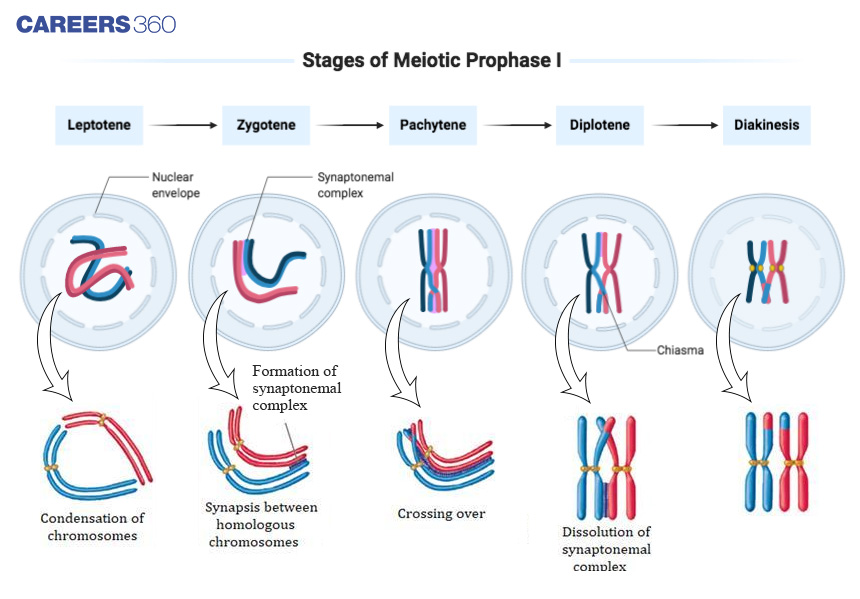
This stage of meiosis is the longest. When compared to the prophase of mitosis, the prophase of the first meiotic division is typically longer and more complicated. Based on chromosomal behaviour, it has been further divided into the following five phases: Leptotene, Zygotene, Pachytene, Diplotene, and Diakinesis.
The chromosomes start to condense during the leptotene stage and eventually achieve a compact structure. As a result, they gradually become visible under a light microscope. Throughout leptotene, chromosomes are still being compacted. The next phase of prophase I is zygotene, which is the second stage.
Also Read| NEET: Insect Resistant Transgenic Plant-Bt Cotton With Questions, Solutions, And Recommended Video
Chromosome pairing and association, or synapsis, begin during this stage. Such paired chromosomes are called homologous chromosomes. Electron micrographs of this stage Shows that chromosome synapsis is accompanied by the formation of a complex structure called the synaptonemal complex. A tetrad or bivalent is the name for the complex created by two homologous chromosomes that have synaptically joined. However, these are more clearly visible in the next stage.
The first two stages of prophase I are relatively short-lived compared to the next stage, which is pachytene.
At this stage, the four chromatids of each bivalent chromosome separate and can be seen as distinct tetrads. Recombination nodules, the locations at which crossing over occurs between non-sister chromatids of the homologous chromosomes, become visible during this stage. The exchange of genetic material between two homologous chromosomes is known as crossing over. Recombinase is the enzyme used in the process of crossing over, which is another enzyme-mediated process. Genetic material on the two chromosomes recombines as a result of crossing over.
By the end of pachytene, recombination between homologous chromosomes is complete, leaving the chromosomes linked at the points of crossing over.
The beginning of diplotene is identified by the dissolution of the synaptonemal complex as well as by the tendency of the recombined homologous chromosomes of the bivalents to separate from each other except at the sites of crossovers. Chiasmata are the X-shaped structures that develop during separation. Diplotene can persist for months or even years in the oocytes of some vertebrate species.
Diakinesis is the last phase of meiotic prophase I. The terminalization of chiasmata is a defining feature of this. The chromosomes are fully condensed during this stage, and the meiotic spindle is put together to get the homologous chromosomes ready for separation. The nuclear envelope also degrades by the time diakinesis is complete, and the nucleolus vanishes. A transition to the metaphase is represented by dialysis.
The process of meiosis, which paradoxically reduces the number of chromosomes by half, is the means by which sexually reproducing organisms maintain the unique chromosome number of each species across generations. From one generation to the next, it also increases the genetic variability in the population of organisms. For the process of evolution, variations are crucial.
Question 1. NEET 2018
Select the incorrect match:
Submetacentric chromosomes - L - shaped chromosomes
Allosomes - Sex chromosomes
Lampbrush chromosomes - Diplotene bivalents
Polytene chromosomes - oocytes of amphibians
Answer: (D)
Diplotene
The synaptonemal complex disintegrates during prophase I's fourth stage, and the bivalents' recombined homologous chromosomes have a tendency to separate. Chiasmata are the names given to the X-shaped structures.
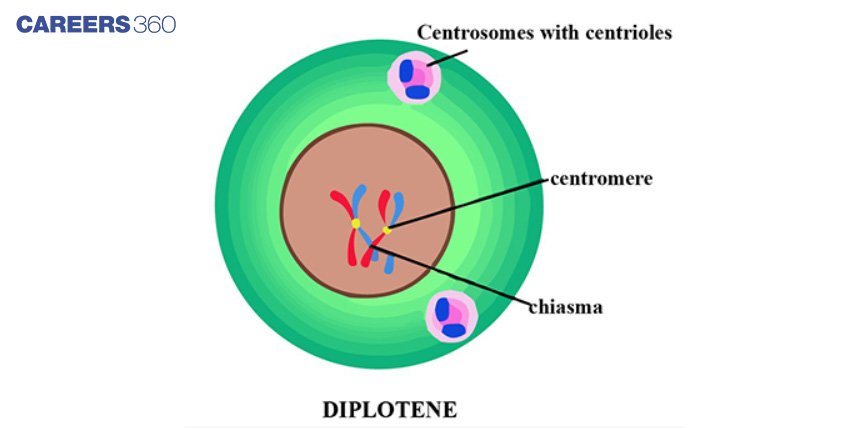
Types of chromosomes -
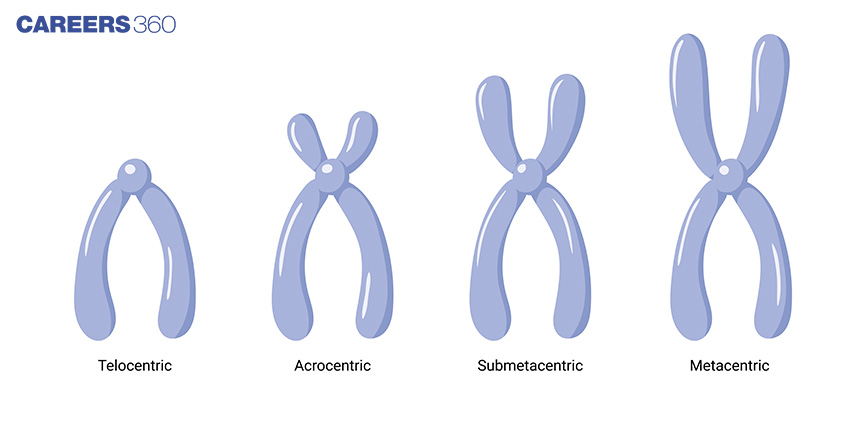
The four different types of chromosomes can be distinguished according to the location of the centromere:
1) Metacentric chromosome- middle centromere forming two equal arms.
2) Sub-metacentric- centromere slightly away from the centre.
3) Acrocentric- centromere is situated close to its end
4) Telocentric- terminal centromere
Insects of the order Diptera have salivary glands that contain polytene chromosomes.
Question 2. NEET 2018
The stage during which separation of paired homologous chromosomes begins is
Diakinesis
Diplotene
Pachytene
Zygotene
Answer: (B)
As we learnt in
Diplotene
The fourth stage of prophase I, marked by dissolution of synaptonemal complex and the tendency of the recombined homologous chromosomes of the bivalents to separate. The X-shaped structures are called chiasmata.
Synaptonemal complex disintegrates. Terminalisation begins at the diplotene stage i.e. chiasmata starts to shift towards end.
Question 3. NEET 2020
Match the following with respect to meiosis:
(a) Zygotene (i) Terminalization
(b) Pachytene (ii) Chiasmata
(c) Diplotene (iii) Crossing over
(d) Diakinesis (iv) Synapsis
(a) (b) (c) (d)
(iii) (iv) (i) (ii)
(a) (b) (c) (d)
(iv) (iii) (ii) (i)
(a) (b) (c) (d)
(i) (ii) (iv) (iii)
(a) (b) (c) (d)
(ii) (iv) (iii) (i)
Answer: (B)
(a) Zygotene - Terminalization
(b) Pachytene - Chiasmata
(c) Diplotene - Synapsis
(d) Diakinesis - Crossing Over
Question 4. NEET 2020
Dissolution of the synaptonemal complex occurs during
Pachytene
Zygotene
Diplotene
Leptotene
Answer: - (C) Diplotene
Diplotene can be identified by the dissolution of the synaptonemal complex and the tendency of the bivalents' recombined homologous chromosomes to separate from one another, save at the sites of crossovers.
Question 5. NEET 2020 - Phase 2
During Meiosis 1, in which stage does synapsis take place?
Zygotene
Diplotene
Leptotene
Pachytene
Answer: (A)
Chromosome pairing and association, also known as synapsis, begin during the Zygotene stage. The term homologous chromosomes refers to such paired chromosomes.
Question 6. NEET 2021
Which stage of the meiotic prophase shows terminalisation of chiasmata as its distinctive feature?
Leptotene
Zygotene
Diakinesis
Pachytene
Answer: (C)
Diakinesis, the last phase of meiotic prophase I, is characterised by the terminalization of chiasmata. The chromosomes are fully condensed and the meiotic spindle is put together to get ready for separating the homologous chromosomes. The nuclear envelope also degrades by the time diakinesis is complete, and the nucleolus vanishes.
If we analyse the past five years’ papers, except 2017 and 2019, all other papers have one to two questions on the topic – Prophase I. From the chapter, Cell Cycle and Cell Division, 18 questions were asked, which has approximately 8% weightage of the total questions asked from Botany. Out of this, six questions were based on the stages of prophase I. Each year, one to two questions are framed from this topic. The Prophase I Of Meiosis I is an important step of the cell cycle and cell division process. NEET aspirants need to understand this scoring topic thoroughly to solve the problems and understand the chapter fully in order to score well.
On Question asked by student community
firstly, for NEET the main requirements are ur own details.. ur name, ur dob, photo, signature and identity proof.. if ur mother's name is slightly different on ur 10th marksheet and her aadhar card, it usually doesnt create any issue during NEET admission or registration as well.. however if there is a major difference then u should consider getting the aadhar updated to avoid confusion during counselling or document verification
Hello,
Here you can access NEET Chapter Wise Question Distribution in Hindi from the mentioned link below:
https://medicine.careers360.com/hi/articles/neet-chapter-wise-weightage-and-important-topics
Hope it helps.
If you are not prepared for NEET with only a month left, skip this attempt and plan calmly for next year or explore other PCB(PHYSICS, CHEMISTRY, BIOLOGY) options like pharmacy, nursing, biotech or psychology. Think about which subjects you will enjoy and what kind of work suitable for you like patient-care, lab work, lab research. If you explore these areas, it will help you to find your real interest.
Hello,
Cracking Neet in 5 months is tough, but not impossible. You must revise the subjects daily, practice lots of PYQ and work on your weak areas. At lastly keep confidence and believe in yourself.
Thank you.
Hello aspirant,
The sample paper PDF can help NEET 2026 candidates better prepare. These NEET 2026 sample papers, which cover questions from physics, chemistry, and biology, adhere to the most recent exam format. Students can learn about question kinds, chapter-wise weighting, and difficulty level by solving the question paper, which also provides them with exam-like practice.
To get the sample papers, you can visit our site through following link:
https://medicine.careers360.com/articles/neet-sample-paper
Thank you
NAAC A+ Accredited| Ranked #24 in University Category by NIRF | Applications open for multiple UG & PG Programs
Among top 100 Universities Globally in the Times Higher Education (THE) Interdisciplinary Science Rankings 2026
Amongst top 3% universities globally (QS Rankings) | Wide Range of scholarships available